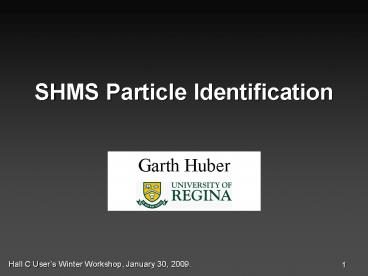SHMS Particle Identification - PowerPoint PPT Presentation
Title:
SHMS Particle Identification
Description:
Worst Fore/Bkd Rate Ratio. 1000:1. 10:1. 4.9-6.7. DIS-parity (E12-07-102) 10000:1. 50:1 ... Worst Fore/Bkd Rate Ratio. 2.2-8.1. Fp (E12-06-101) PSHMS (GeV/c) Expt. 10 ... – PowerPoint PPT presentation
Number of Views:20
Avg rating:3.0/5.0
Title: SHMS Particle Identification
1
SHMS Particle Identification
Hall C Users Winter Workshop, January 30, 2009.
2
The limitation of TOF
- TOF over the short 2.2m baseline inside the SHMS
hut will be of little use for most of the
momentum range anticipated for the SHMS. - Even over a 22.5m distance from the target to the
SHMS detector stack, TOF is of limited use.
Effect of finite timing resolution (1.5s with
s200ps). Separation lt3s to the right of where
lines intersect.
3
Non-TOF techniques
- Efficient, high-confidence PID requires extensive
use of non-TOF techniques such as Cerenkov
detectors. - Good PID can be obtained with a series of
Cerenkov detectors - e-/p- ? Noble Gas Cerenkov (n-1 lt 10-4)
- p/K ? Heavy Gas Cerenkov (n-1 10-3)
- K/p ? Aerogel Cerenkov (n-1 0.05)
- Lead Glass Calorimeter also plays a critical role
in e-,e identification.
4
Hall-C SHMS Detector System
Noble Gas Cerenkov e/p separation at high
momenta, where multiple-scattering is less of an
issue. Trigger Hodoscopes Time-of-Flight at
low momenta insensitive to photon or low-energy
background. Heavy Gas Cerenkov p/K separation
for Pgt3.4 GeV/c. Aerogel Cerenkov(s) Depending
on the n used, K/p separation or p/K separation
at low momenta. Lead Glass Calorimeter e/p
separation.
5
Calorimeter e/p separation
- Lead-Glass Block / PMT / Base Assemblies from
HERMES. - Expect gt2001, based on HMS Calorimeter
performance.
6
Noble Gas Cerenkov e/p (or p /K) separation at
high momenta
- 2.5 m long gas radiator at atmospheric pressure.
- Argon p threshold 6 GeV/c.
- Adding Neon p threshold may be varied up to 12
GeV/c. - Para-Terphynyl PMT window over-coating .
- Performance 20 photoelectrons
- (worst case pure Neon).
- At low momenta remove mirrors,
- insert coupling so that the tank
- becomes part of the vacuum
- system reduces MCS.
7
Heavy Gas Cerenkov p/K separation for momenta gt
3.4 GeV/c
To maintain good p/K separation, it is necessary
to reduce the gas pressure above 7 GeV/c.
Lowest p identification efficiency occurs at
3.4 GeV/c (10 p.e.).
8
Electron-Pion Discrimination
- The most stringent requirements arise when the
SHMS is set to negative polarity. - Both e-/p- and p-/e- separations are required
Expt PSHMS (GeV/c) Worst Fore/Bkd Rate Ratio Noble Gas C Pb-G Cal Total ep Reject
Fp (E12-06-101) 5.1,6.5 1 (p-)1000(e-) 501 2001 100001
SIDIS pT (PR12-09-017) 1.5-5.0 1 (p-)10 (e-) Not used for lowest P. 2501 2501
xgt1 (E12-06-105) 4.8-10.6 1(e-)50(p-) 501 1001 50001
DIS-parity (E12-07-102) 4.9-6.7 3(e-)1(p-) 101 1001 10001
9
Pion-Kaon Discrimination
- Equally applicable for positive or negative SHMS
polarity. - Supplemental Aerogel or TOF must supplement Heavy
Gas Cerenkov at low momentum.
Expt PSHMS (GeV/c) Worst Fore/Bkd Rate Ratio Heavy Gas C Pgt3.4 GeV/c Aerogel C Plt3.4 GeV/c (n1.010)
Fp (E12-06-101) 2.2-8.1 2(p)3(Kp) 10001 3001
CT (E12-06-107) 5.1-9.6 1(p)1(Kp) 10001 NA
p Factorization (E12-07-102) 2.4-8.5 2(p)3(Kp) 10001 3001
K Factorization (PR-09-011) 2.6-7.1 1(K)30(p) 10001
10
Aerogel Cerenkov
- Reliable K/p separation over a wide momentum
range is a challenge. - Although only one aerogel Cerenkov is required at
any particular momentum, two detectors would
allow flexibility over a greater range. - K/p separation gets progressively more difficult
as (n-1) is reduced at higher momenta.
pSHMS (GeV/c) n (10cm) K p.e. p p.e.
2.5-3.0 1.030 13-46 lt0.5
3.1-3.7 1.020 12-31 lt0.5
3.8-4.3 1.015 13-24 lt0.5
4.4-5.1 1.010 5.5- lt0.5
5.2-6.2 1.0075 5.5-13 lt1
6.4-7.3 1.0055 6-9 lt1
11
Kaon-Proton Discrimination
- Only relevant for SHMS positive polarity.
- Several experiments have similar stringent
requirements
Expt Momenta (GeV/c) Worst Fore/Bkd Rate Ratio Aerogel C (worst case)
CT (E12-06-107) 5.1-9.6 1(K)10(p) 1001
SIDIS pT (PR12-09-017) 1.5-5.0 2001
K Factorization (PR12-09-011) 2.6-7.1 1(K)3(p) 1001
Additional PID helpful at higher P
12
Supplementary K/p 7 GeV/c
- pCDR includes a supplemental K/p identification
technique utilizing the dE/dx distribution of
particles traversing the wire chambers. - Requires analog readout for groups of wires.
7 GeV/c pK
Cut placed at 75 likelihood results in 2001 pK
sep. separation with 95 efficiency.
Likelihood
13
Summary
- Particle identification requirements of approved
and proposed SHMS experiments are largely met by
the planned detector package. - At least one Aerogel Cerenkov is required for p
identification at Plt3.4 GeV/c and for K
identification up to at least 5 GeV/c. - The need to supplement K identification at higher
momenta seems clear. - Addition of pulse-height info to the wire chamber
readout is a particularly attractive option. - Requires new readout electronics, but cost is
offset by the need for fewer sets of aerogel
(different n) and less overhead when changing
momentum. - Likely cost effective over the longer term.































